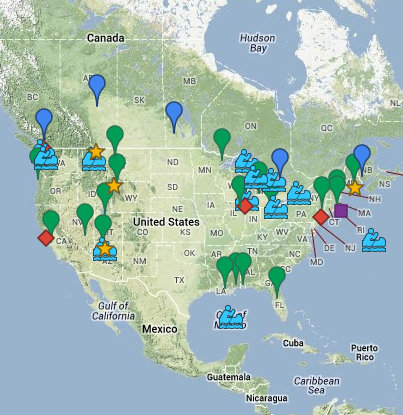None of which has much to do with this post, which simply highlights City Beach in Sandpoint. Historical photos on the web show a lot of saw mills and train tracks, but don't provide much evidence of what this spit-like landform at the mouth of Sand Creek looked like prior to development.
Thursday, July 04, 2019
Sandpoint
The small city of Sandpoint, Idaho, lies at the northwestern end of Lake Pend Oreille, near its outlet to the Pend Oreille River, which in turn flows into the Columbia just north of the Canadian border (although it has to first flow through the powerhouse at Seattle City Light's Boundary Dam in order to generate some of the watts that run my computers and my air conditioner).
The Clark Fork River is the largest inflow to the lake and drains a large portion of western Montana. During the waning stages of the last glaciation, about 15,000 years ago, ice advanced south from Canada into the area that is now the north end of Lake Pend Oreille, blocking the Clark Fork and creating Lake Missoula (Lake Missoula and Camas Prairie). Or actually, many Lake Missoulas, as the ice dam kept breaching, emptying the lake, and multiple large floods swept across this landscape and southwest into Washington (Frenchman Coulee and Potholes Coulee).
None of which has much to do with this post, which simply highlights City Beach in Sandpoint. Historical photos on the web show a lot of saw mills and train tracks, but don't provide much evidence of what this spit-like landform at the mouth of Sand Creek looked like prior to development.
AERIAL VIEW
What was lumber-based industry is now lake-oriented recreation - beaches and boats and hotels. The sand appears to have been imported and piled along the shoreline, where waves have redistributed it to form a series of small beaches that wrap around the point. This movement of sand, and ultimately the shape of the beaches, is influenced by several groin-like structures. (If it turns out that these beaches are completely natural, and I'm completely off base, my apologies, but it's really hard for me to explain them without human intervention).
None of which has much to do with this post, which simply highlights City Beach in Sandpoint. Historical photos on the web show a lot of saw mills and train tracks, but don't provide much evidence of what this spit-like landform at the mouth of Sand Creek looked like prior to development.
Subscribe to:
Post Comments (Atom)





No comments:
Post a Comment